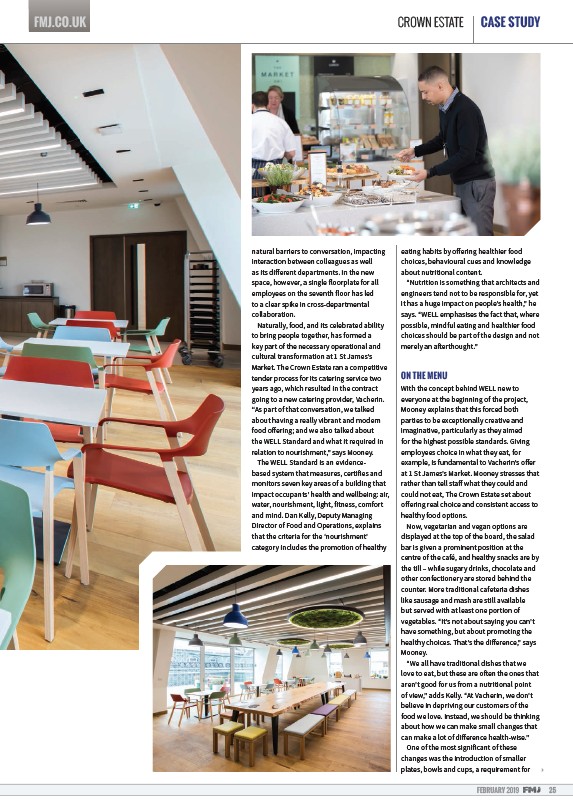
FMJ.CO.UK CROWN ESTATE CASE STUDY
FEBRUARY 2019 25
natural barriers to conversation, impacting
interaction between colleagues as well
as its di erent departments. In the new
space, however, a single floorplate for all
employees on the seventh floor has led
to a clear spike in cross-departmental
collaboration.
Naturally, food, and its celebrated ability
to bring people together, has formed a
key part of the necessary operational and
cultural transformation at 1 St James’s
Market. The Crown Estate ran a competitive
tender process for its catering service two
years ago, which resulted in the contract
going to a new catering provider, Vacherin.
“As part of that conversation, we talked
about having a really vibrant and modern
food o ering; and we also talked about
the WELL Standard and what it required in
relation to nourishment,” says Mooney.
The WELL Standard is an evidencebased
system that measures, certifies and
monitors seven key areas of a building that
impact occupants’ health and wellbeing: air,
water, nourishment, light, fitness, comfort
and mind. Dan Kelly, Deputy Managing
Director of Food and Operations, explains
that the criteria for the ‘nourishment’
category includes the promotion of healthy
eating habits by o ering healthier food
choices, behavioural cues and knowledge
about nutritional content.
“Nutrition is something that architects and
engineers tend not to be responsible for, yet
it has a huge impact on people’s health,” he
says. “WELL emphasises the fact that, where
possible, mindful eating and healthier food
choices should be part of the design and not
merely an a’ erthought.”
ON THE MENU
With the concept behind WELL new to
everyone at the beginning of the project,
Mooney explains that this forced both
parties to be exceptionally creative and
imaginative, particularly as they aimed
for the highest possible standards. Giving
employees choice in what they eat, for
example, is fundamental to Vacherin’s o er
at 1 St James’s Market. Mooney stresses that
rather than tell sta what they could and
could not eat, The Crown Estate set about
o ering real choice and consistent access to
healthy food options.
Now, vegetarian and vegan options are
displayed at the top of the board, the salad
bar is given a prominent position at the
centre of the café, and healthy snacks are by
the till – while sugary drinks, chocolate and
other confectionery are stored behind the
counter. More traditional cafeteria dishes
like sausage and mash are still available
but served with at least one portion of
vegetables. “It’s not about saying you can’t
have something, but about promoting the
healthy choices. That’s the di erence,” says
Mooney.
“We all have traditional dishes that we
love to eat, but these are o’ en the ones that
aren’t good for us from a nutritional point
of view,” adds Kelly. “At Vacherin, we don’t
believe in depriving our customers of the
food we love. Instead, we should be thinking
about how we can make small changes that
can make a lot of di erence health-wise.”
One of the most significant of these
changes was the introduction of smaller
plates, bowls and cups, a requirement for